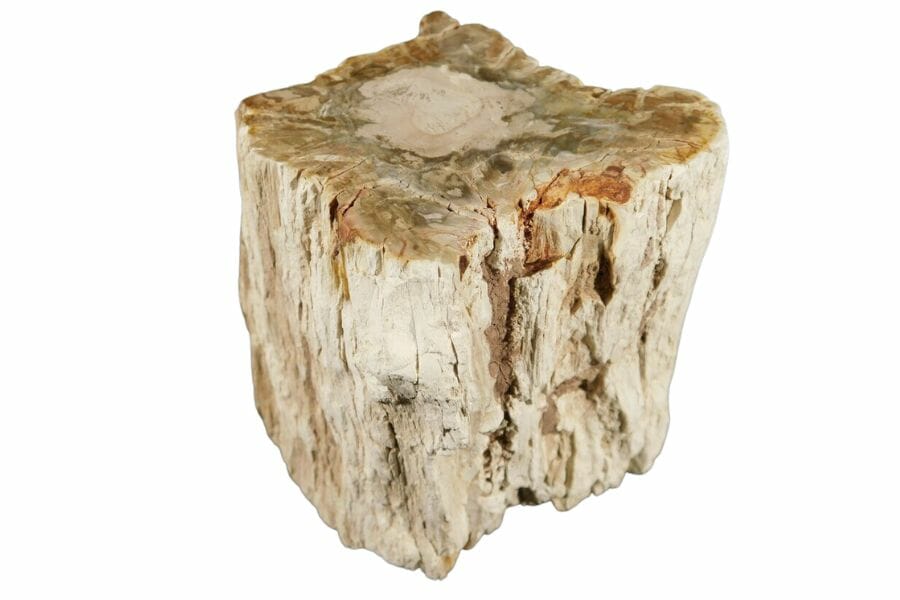Florida is known for sunny beaches, alligators, and orange groves. But did you know that Florida is also a great place to find petrified wood?
Petrified wood is basically ancient wood that’s turned into stone. Think of it as nature’s way of capturing a moment in time. Over the years, the wood gets buried by layers of mud and other materials.
As time passes, the original wood gets replaced by minerals, and voilà, it becomes a beautiful stone with the shape and sometimes even the texture of the original wood.
Florida’s rich history and unique landscape make it a hotspot for this natural wonder. From the cool rivers to the quiet forests, you can discover pieces of ancient trees that lived millions of years ago.
What Is Florida Petrified Wood
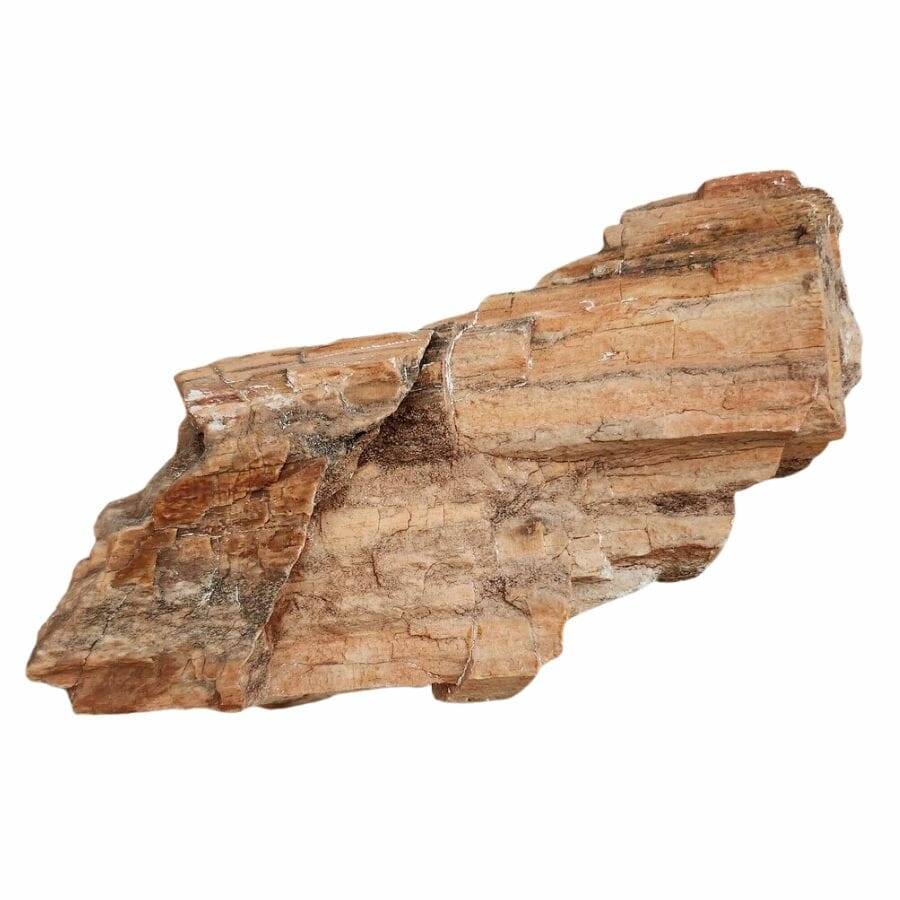
Petrified wood is ancient wood that has turned into stone over time. When trees die and fall, they sometimes get buried under mud, sand, or volcanic ash. This covering protects the wood from rotting away.
Slowly, groundwater rich in minerals flows around the buried wood. These minerals start to fill in the spaces in the wood and replace the original plant material.
After many, many years, the wood changes into solid stone, but it keeps the shape, and sometimes even the patterns, of the original wood.
You can often uncover petrified wood in areas that were once rich in trees but got covered quickly by volcanic eruptions or other natural events. Dry, desert regions and riverbanks are common spots.
But remember, always check local rules before collecting. Some places protect petrified wood as a special natural resource!
The types of petrified wood found in Florida
As we delve deeper, you’ll be amazed by the different kinds of petrified wood waiting to be discovered here! Before you go, however, make sure that you know how to identify petrified wood. This way, you’ll know what to look out for.
Silicified wood
Silicified wood is an awesome piece of nature’s artwork! It’s a type of petrified wood, but with a special twist. When a tree dies and gets buried, sometimes the groundwater that moves around it is rich in a mineral called silica.
Over time, this silica soaks into the wood and starts replacing the original wood fibers. The process is a bit like filling a sponge with glue. Eventually, the whole piece of wood turns into stone because of the silica.
The cool part? Silicified wood keeps a lot of the details from the original tree. You can often see patterns, rings, and even the bark’s texture. This wood-turned-stone is a snapshot of what the world looked like a long, long time ago.
Opalized wood
Opalized wood is like nature’s own sparkle show! It happens when wood becomes petrified with opal, a gemstone known for its rainbow of colors.
Like with silicified wood, when trees die and get buried, mineral-rich water can flow around them. If this water is filled with tiny opal particles, they’ll start to replace the wood’s natural material.
Over a super long time, the wood changes, and instead of becoming just a regular stone, it becomes shiny and colorful because of the opal. You can find bits of the original tree structure, but with a shimmering, dazzling twist.
- The extensive local experience of our team
- Input from a variety of local rockhounds and rockhound groups
- The difficulty in accessing a location
- Safety and potential hazards when collecting
- Private and public locations
- A desire to include locations for both the experienced and newbie hunters who are just starting out
Using these inputs we think we’ve put together the best list out there for those who love finding petrified wood for our collections!
If you want REAL results finding incredible rocks and minerals you need one of these 👇👇👇
Finding the coolest rocks in isn’t luck, it's knowing what to look for. Thousands of your fellow rock hunters are already carrying Rock Chasing field guides. Maybe it's time you joined the community.
Lightweight, mud-proof, and packed with clear photos, it’s become the go-to tool for anyone interested discovering what’s hidden under our red dirt and what they've already found.
Join them, and make your next rockhounding trip actually pay off.
What makes it different:
- 📍 Find and identify 140 incredible crystals, rocks, gemstones, minerals, and geodes across the USA
- 🚙 Field-tested across America's rivers, ranchlands, mountains, and roadcuts
- 📘 Heavy duty laminated pages resist dust, sweat, and water
- 🧠 Zero fluff — just clear visuals and straight-to-the-point info
- ⭐ Rated 4.8★ by real collectors who actually use it in the field
The Best Places To Find Petrified Wood In STATE
When it comes to exploring the fascinating world of petrified wood, the rockhounding spots in Florida are a true playground for discovery.
Dive in and let’s explore some of the best spots:
Always Confirm Access and Collection Rules!
Before heading out to any of the locations on our list you need to confirm access requirements and collection rules for both public and private locations directly with the location. We haven’t personally verified every location and the access requirements and collection rules often change without notice.
Many of the locations we mention will not allow collecting but are still great places for those who love to find beautiful rocks and minerals in the wild without keeping them. We also can’t guarantee you will find anything in these locations since they are constantly changing.
Always get updated information directly from the source ahead of time to ensure responsible rockhounding. If you want even more current options it’s always a good idea to contact local rock and mineral clubs and groups
Peace River
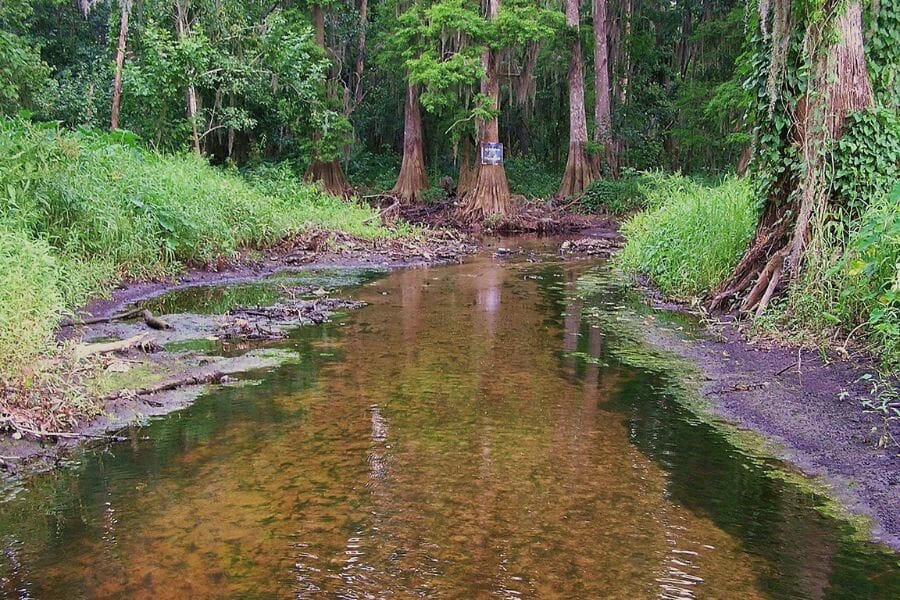
The Peace River in Florida is a real gem for nature lovers and rockhounds! Stretching over 100 miles, this river starts in the Green Swamp near Bartow and flows southwest until it meets Charlotte Harbor.
Its path takes it through some of Florida’s most beautiful landscapes, including thick forests and marshy wetlands.
What’s special about the Peace River is its rich geology. Over time, the river has carved out layers of the earth, revealing fossils and unique stones from ancient days.
Many rockhounds visit to search for shark teeth, bones, and other cool treasures. The river’s shallow waters make it easier to spot these finds.
The terrain around the Peace River is a mix. There are sandy banks, wooded areas, and spots with limestone outcrops. It paints a vibrant picture of Florida’s diverse landscape.
Getting to the Peace River is a breeze! There are multiple access points along its course, and many of them have parks or recreation areas.
Whether you want to paddle, hunt for fossils, or just enjoy the scenery, the Peace River is a must-visit for anyone in Florida!
Where we found petrified wood along the Peace River
As you explore the riverbanks and shallow waters, you might find pieces of Florida petrified wood. Over time, minerals replaced the wood, preserving its shape and details.
The river’s winding course has pockets where petrified wood collects, making it an exciting spot for any rockhound. So, grab your gear and head to Peace River; you’re in for a treat!
Lakeland
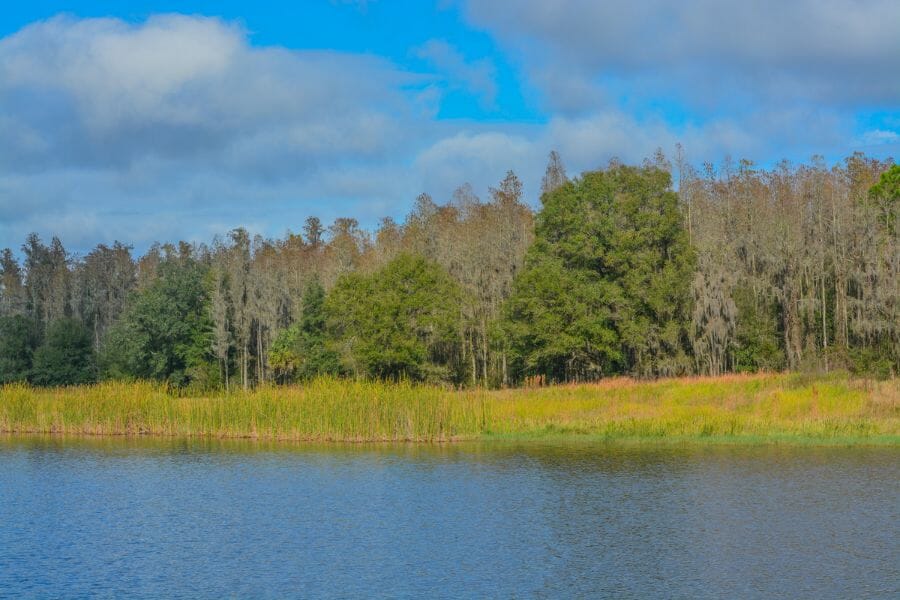
Lakeland, Florida is a bustling city that lives up to its name with stunning lakes all around. Nestled between Tampa and Orlando, Lakeland is home to 38 gorgeous lakes, each one offering a unique slice of Florida’s natural beauty.
Whether you’re into boating, fishing, or just relaxing by the water, Lakeland’s lakes are a central part of life here.
Geographically, Lakeland has a mostly flat terrain, sprinkled with gentle rolling hills. It’s not just the lakes that make Lakeland interesting; the area’s geology is fascinating too.
With an abundance of phosphate mines nearby, it’s a hot spot for fossil enthusiasts, who often find treasures like shark teeth and ancient bones.
The city’s landscape also includes parks, trails, and woodlands, giving outdoor enthusiasts plenty to explore. From the scenic beauty of the Lake-to-Lake Park to the adventurous terrain of the Circle B Bar Reserve, there’s something for everyone.
Getting to Lakeland is a snap! Its central location means it’s easily accessible by major highways like I-4, and the local public transportation options are handy too.
Where we found petrified wood in Lakeland
One place to look is just 2 miles east at Saddle Creek, right near a phosphate mine. Phosphate mines often uncover all sorts of cool rocks and fossils
Another promising location is 2 miles northeast of Lake Parker, also at a phosphate mine. These mines have dug up bits of Florida’s ancient past, and it’s not rare to stumble upon petrified wood here.
Suwannee River
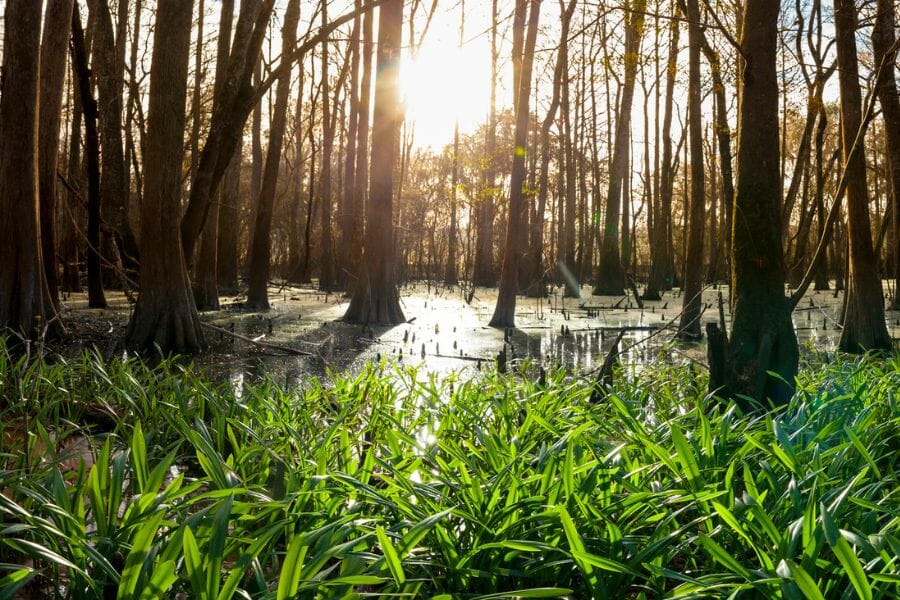
The Suwannee River is one of Florida’s natural treasures! It flows over 240 miles from the Okefenokee Swamp in Georgia all the way to the Gulf of Mexico in Florida. As it travels, the river winds through scenic forests, limestone springs, and wetlands.
The river’s geology is a treat for rockhounds. The Suwannee is famous for its limestone springs and underwater caves. Over time, the river has carved into this limestone, creating beautiful springs and exposing fossils from ages past.
Terrain-wise, the areas around the Suwannee offer a mix of sandy banks, hardwood forests, and marshes. Plus, there are some spots where you can see limestone outcrops popping up, telling tales of the land’s ancient history.
Now, getting to the Suwannee River is simple! It’s well-marked and there are numerous parks, springs, and recreation areas along its course.
Where we found petrified wood at Suwannee River
Near the riverbanks and in the shallows, you can often find bits of petrified wood. The river’s natural flow exposes these treasures, especially after heavy rains.
Levy County
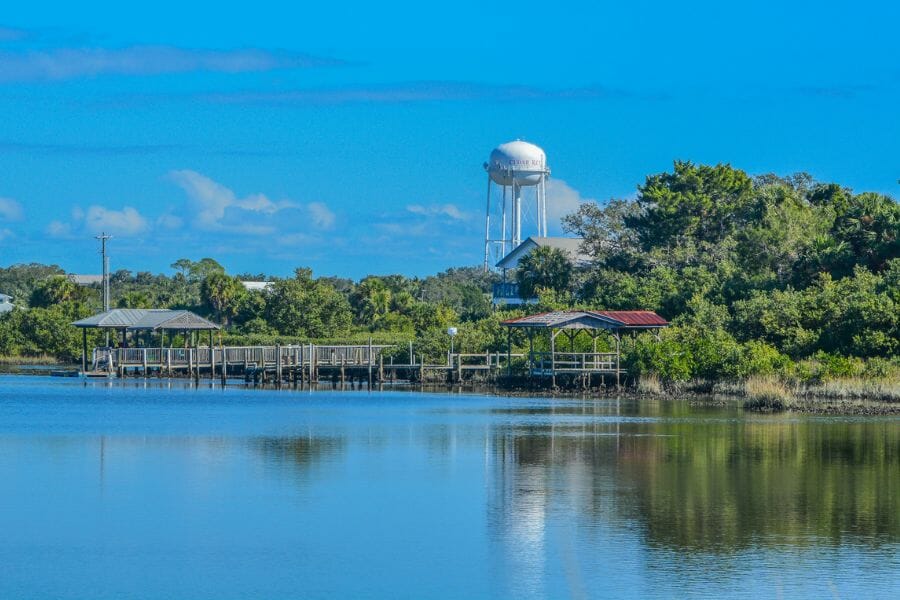
Levy County is a hidden gem located in the northern part of Florida. Geographically, it’s tucked between the Gulf of Mexico and central Florida, offering a mix of coastal areas and inland forests.
The county boasts beautiful terrain, with a blend of sandy beaches, dense woods, and shimmering lakes.
From a geology standpoint, Levy County is a treat. It sits atop layers of limestone, which means there are many springs, sinkholes, and underwater caves waiting to be explored.
The limestone-rich land also holds clues to Florida’s prehistoric past. Rockhounds can sometimes find fossils and unique minerals in this region.
Getting to Levy County is a breeze. Main roads, like U.S. Route 19, pass right through the heart of the county. It’s well-connected, so whether you’re coming from southern Florida or from the north, you can reach it without a hitch.
Where we found petrified wood in Levy County
One of the best places to search is in the quarries spread across the county. These quarries dig deep into the Earth, they expose pieces of petrified wood.
If you’re planning a trip to Levy County, remember to get permission before exploring any quarries.
Bone Valley Formation
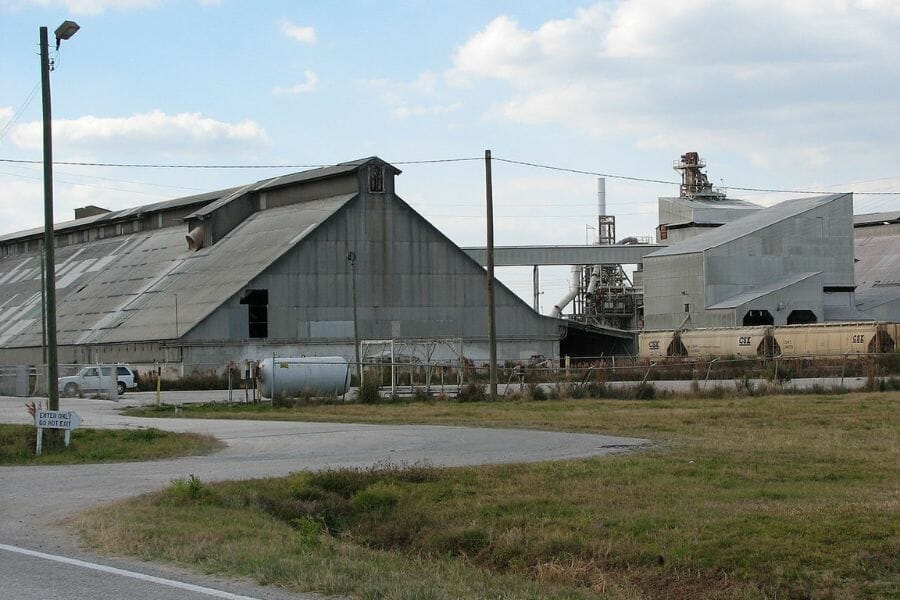
The Bone Valley Formation in Florida is like a time capsule for rockhounds! It’s located in the central part of the state, covering areas of Polk, Hardee, Hillsborough, and Manatee counties.
This region is known for its rolling landscapes with a mix of flatlands and gentle hills.
Geologically, the Bone Valley Formation is super special. It’s a layer of the Earth that’s packed with phosphate rock, which is important for making fertilizer.
Over time, ancient animals like sharks, whales, and even mammoths lived here, leaving their bones and teeth behind. Today, rockhounds often find these amazing fossils while exploring.
The terrain here is diverse. There are open mines, dense forests, and wetlands that paint a vivid picture of Florida’s varied landscape.
Reaching the Bone Valley Formation isn’t tricky at all. Major highways like US-27 and I-75 run nearby. But remember, many areas are actively mined or are on private land, so always get permission before you start your fossil adventure.
Where we found petrified wood at the Bone Valley Formation
When exploring, rockhounds can often find bits of petrified wood, especially near old mine areas. If you’re on the hunt in the Bone Valley Formation, always be sure you’re searching in places where you have permission.
Other Great Places To Find Florida Petrified Wood
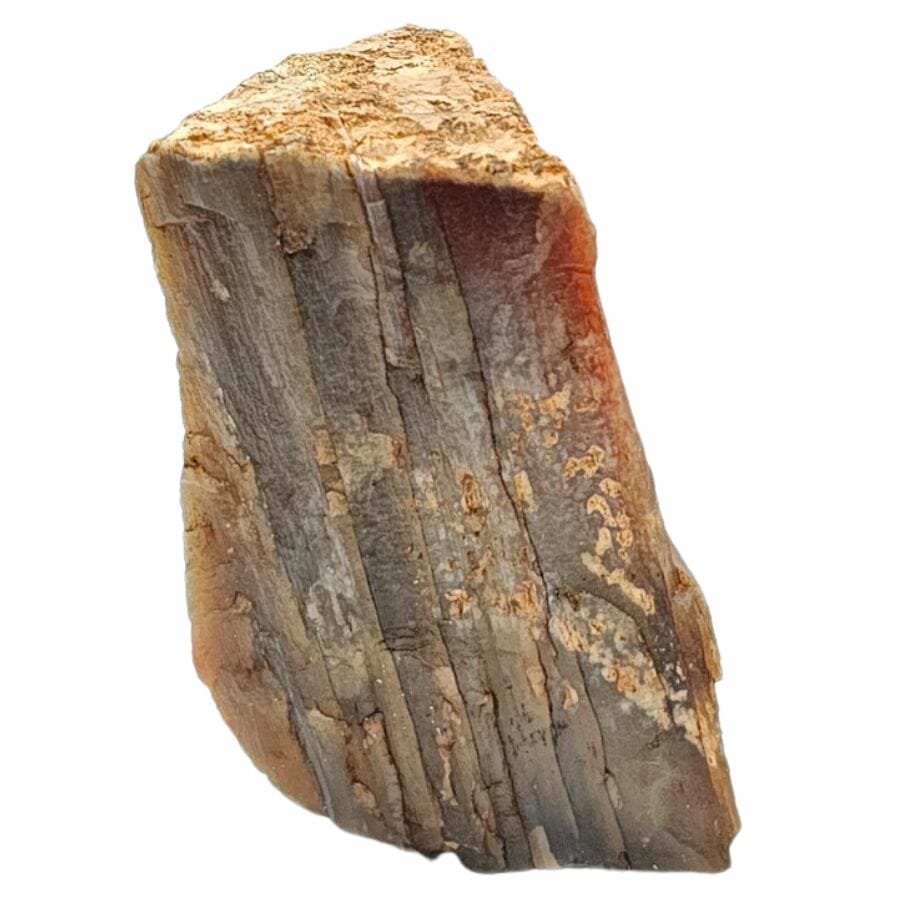
Knowing where to find petrified wood is essential for avid rockhounds. Aside from our recommendations above, you can also look in these places for petrified wood in Florida:
| County | Location |
| Gadsden County | Fuller’s earth mines in the Havana area |
| Gadsden County | Abandoned fuller’s earth mines, north toward the Georgia border in Hinson |
| Gadsden County | Fuller’s earth mines in the Jamieson area |
| Gadsden County | Fuller’s earth mines northeast of the Withalacoochee River and 8 miles north on SR-65 in the Quincy area |
| Gilchrist County | Various quarries |
| Gilchrist County | Santa Fe River |
| Hamilton County | Phosphate mining operations north of White Springs |
| Lafayette County | Various quarries |
| Polk County | Phosphate mines in the Lake Hookers Prairie area in Bradley |
| Polk County | Phosphate digging operations |
| Polk County | Phosphate mines east of SR-60 in the Mulberry area |
General Areas You Should Try
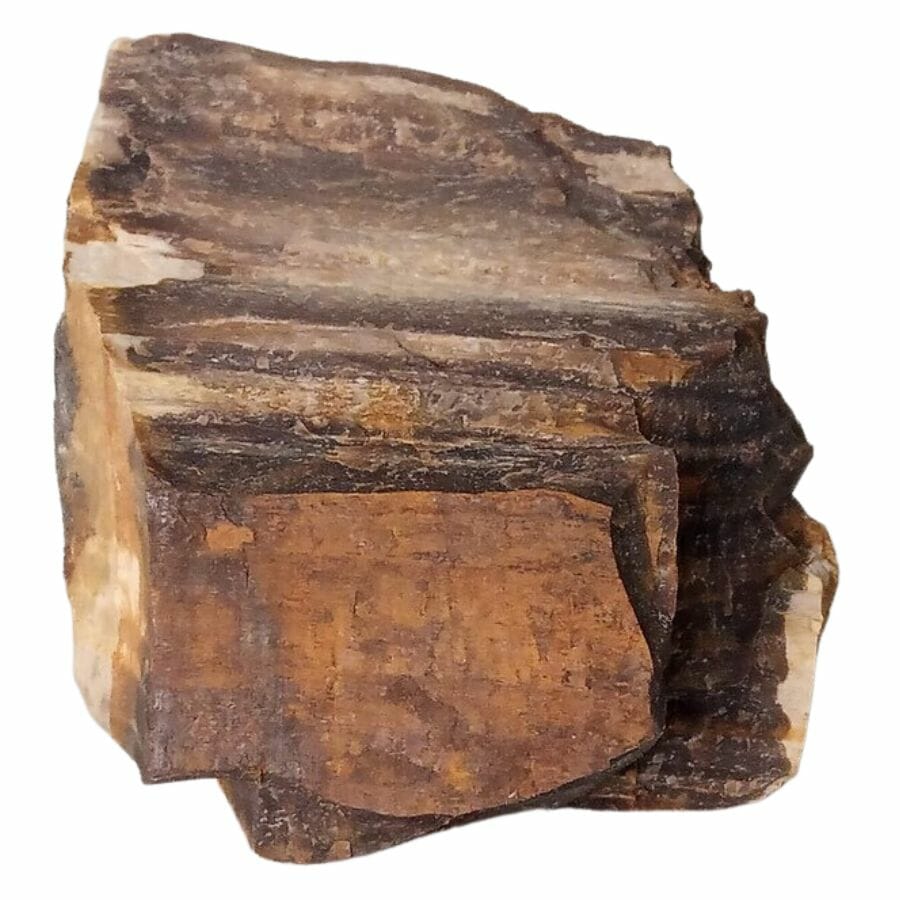
If you’ve ever wondered how to find petrified wood, you’re in for an exciting adventure! The areas below are the usual places where petrified wood can be found. If you try your luck, you might just come away with some awesome discoveries.
Rivers and riverbanks
Rivers and riverbanks are like treasure troves for collectors searching for petrified wood. Why? Because these places have a knack for uncovering and gathering ancient pieces of wood that have turned to stone.
Petrified wood forms when trees are buried under sediment and then, over millions of years, the organic parts are replaced with minerals. The wood’s structure remains, but the material becomes solid like rock.
Now, rivers play a big part in this process. As rivers flow, they wear away the land and dig up layers of earth. This action can uncover petrified wood that’s been buried for ages.
The pieces of petrified wood then tumble along the riverbed, and the current smooths and polishes them.
Riverbanks, too, are hot spots for finding petrified wood. Over time, the river may shift, leaving behind piles of rocks and petrified wood on the banks. As the water rises and falls with the seasons, new treasures can be exposed.
So, for collectors, rivers and riverbanks are ideal places to search. With patience, a keen eye, and maybe a little bit of splashing around in the water, you might find a piece of ancient forest that’s now a beautiful rock!
Phosphate mines
Phosphate mines are like hidden vaults for collectors who love petrified wood! Phosphate is mined from deep layers of the Earth that have been forming for millions of years.
During this long time, many things, like trees, got buried and trapped in these layers.
When trees get buried quickly under sediment, there’s less chance for them to rot away. Instead, over time, the organic parts of the wood get replaced with minerals, turning the wood to stone, or “petrifying” it.
Since phosphate mines dig deep into these ancient layers, they often stumble upon this petrified wood.
Now, in the process of mining, large machines remove and shift tons of earth. As they do, they reveal and bring up chunks of petrified wood.
This means that collectors often find bigger and better-preserved pieces in mines than in other places.
However, a word of caution! Mines can be dangerous, and many are on private property. Always make sure you have permission to be there and take necessary safety precautions.
Beaches
Beaches are fantastic spots for collectors to discover petrified wood! The magic of the beach lies in its constant movement and change. Waves and tides play a big role.
As they wash over the shore, they pull and push all sorts of treasures, including pieces of petrified wood.
You see, when trees from ancient times got buried and slowly turned to stone, they often ended up in or near water sources. Over time, these petrified pieces might break free and start their journey to the sea.
Walking on the beach, you can often find petrified wood mixed in with pebbles, shells, and seaweed. They stand out because of their unique patterns that look like wood grain, but with the hardness of stone.
Another cool thing is that beaches are always changing. One day, you might find nothing, but after a storm or high tide, new treasures can appear.
So, for anyone who loves collecting, beaches offer a fun and ever-changing playground to hunt for ancient bits of forests turned to stone!
Common Questions About Finding Petrified Wood In Florida
These are the answers to some of the commonly asked questions about petrified wood in the state:
How old is petrified wood in Florida?
Most of the petrified wood found here dates back to a period called the Miocene epoch. This epoch began around 23 million years ago and ended about 5.3 million years ago.
During the Miocene, the climate was warmer, and Florida’s landscapes were home to a mix of plants and animals, some of which are no longer around today. Over time, trees from this period got buried quickly, which protected them from rotting.
So, in a nutshell, Florida petrified wood is typically between 5.3 to 23 million years old.
Can you find petrified palm wood in Florida?
Absolutely, you can find petrified palm wood in Florida! Florida’s ancient past was home to a variety of trees, including palm trees. The organic material in the wood was replaced by minerals, turning the palm wood into stone.
This process kept the unique pattern of the palm, so it’s different from other types of petrified wood.
Petrified palm wood stands out because it has dot-like patterns which are actually the spots where the palm had its branches. When you find a piece, it’s like holding a snapshot of Florida from millions of years ago!
If you’re out searching in Florida, especially in areas known for petrified wood, keep an eye out for these special dotted patterns.
The Best Places To Buy Petrified Wood In Florida

You can buy petrified wood specimens from these local stores:
- The Rock Shop – 445 Eglin Pkwy NE, Fort Walton Beach, FL 32547
- Earth Treasures – 207 West Miami Ave W, Venice, FL 34285
- We Rock Rocks – 3445 C, E Bay Dr, Largo, FL 33771
- Black Market Minerals – 5770 W Irlo Bronson Memorial Hwy #401, Kissimmee, FL 34746
- Ye Olde Rock Shoppe – 1425 S 30th Ave C, Hollywood, FL 33020

